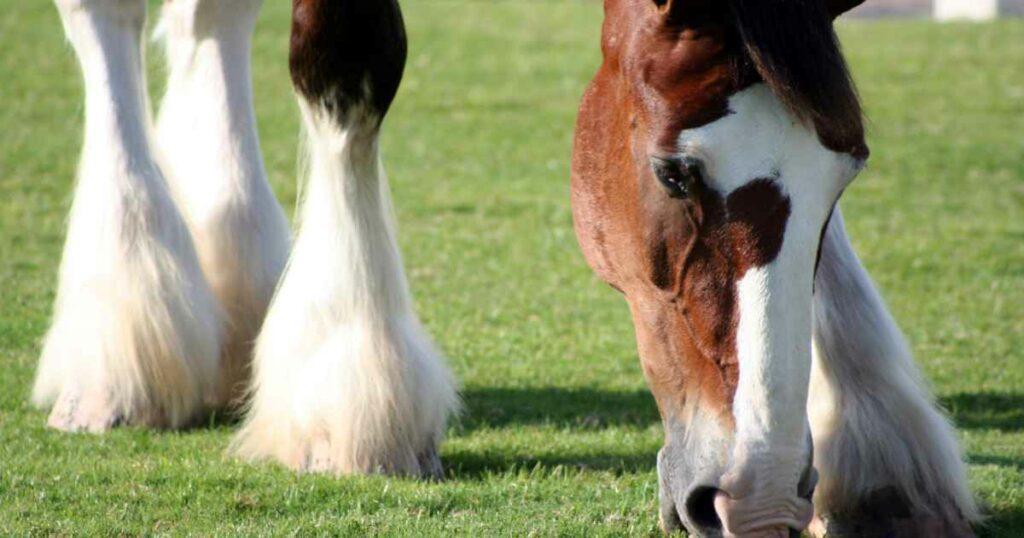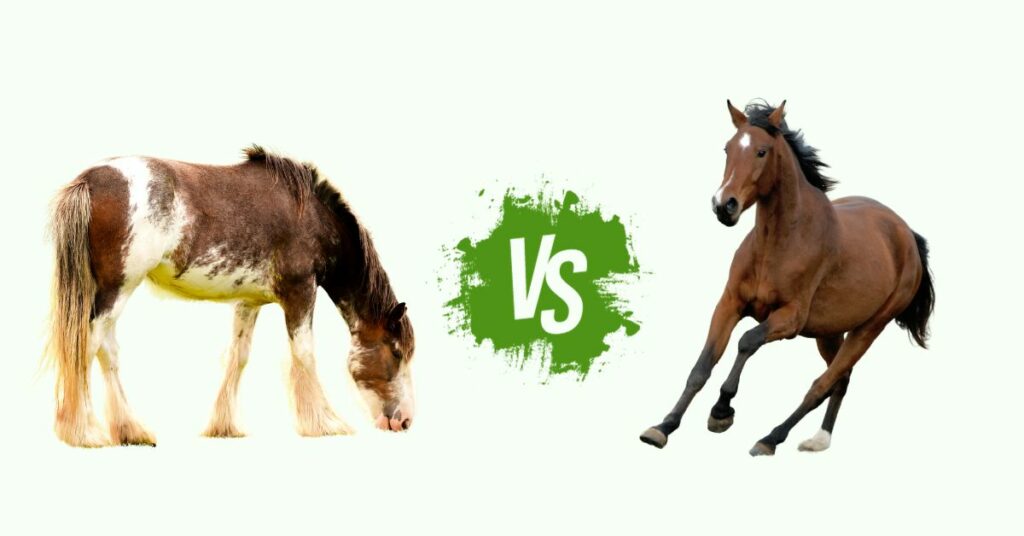As an Amazon Associate we earn from qualifying purchases.
Which horse is better for you, Clydesdale horse vs Regular Horse? Clydesdales are a majestic breed of horse, known for their impressive size and strength. These stunning animals are a popular choice for many horse enthusiasts, and have been used for centuries to carry goods, pull carriages, and even race. But what makes Clydesdales so unique, and how do they compare to regular horses?
What Is A Clydesdale Horse?
A Clydesdale horse is a breed of draft horse originating in Scotland. These horses are known for their large size and striking white feathered legs. Clydesdales are typically bay in color, but can also be black, brown, or gray. They stand between 16 and 18 hands high and weigh between 1,800 and 2,000 pounds.
For more information about the Clydesdale horse breed follow this link.
The breed is known for its power, strength, and grace. They are often seen in carriage and wagon teams and are used in many equestrian events. The breed is also used for show and pleasure riding. Clydesdales have been used for centuries for agricultural and transportation purposes, and still remain popular today.
What Is A Regular Horse?
A regular horse is any breed of horse that has not been specifically bred for a purpose. Some common breeds associated with being regular horses are Quarter Horse, Paint Horse, Mustang, Appaloosa, Arabian, Mustang, and Thoroughbred. These breeds are known for their gentle temperaments and willingness to work with humans.
SEE ALSO : 10 Arabian Horse Facts That Will Blow Your Mind!
Regular horses are often used for riding, as well as other activities such as trail riding, pleasure riding, and showing. They are also used in a variety of disciplines, including show jumping, dressage, and eventing. Regular horses are generally easy to train and provide a great companion for those who love horses.
Clydesdale Horse vs Regular Horse – Size & Weight

Clydesdales typically stand between 16 and 18 hands high. This makes them much larger than a regular horse, which typically stands between 14 and 16 hands high.
In terms of weight, Clydesdales typically weigh up to 2,000 pounds, while regular horses can weigh up to 1,500 pounds.
If you are looking for a big horse, a Clydesdale might be the right choice for you, if you want something smaller go for a regular horse.
Clydesdale Horse vs Regular Horse – Strength
Clydesdale horses are significantly larger and stronger than regular horses. The Clydesdale’s powerful frame is capable of carrying heavier loads than most other horse breeds. Additionally, they have large, muscular legs which give them great balance and stability, making them perfect for farm work, riding, and pulling carriages.
They also have a strong back, allowing them to pull heavier loads more easily. This strength advantage allows them to be used in more demanding tasks, such as pulling carriages and wagons, than regular horses.
If you want a strong and powerful horse, then you should go for a Clydesdale. These horses are much larger and stronger than regular horse breeds, and can be quite impressive to behold.
To find out Clydesdale horse prices click this link.
Clydesdale Horse VS Regular Horse – Personality
In terms of personality, Clydesdales are known for being gentle giants. These horses have laid-back personalities and are generally easy to train and handle. They are also very loyal and devoted to their owners, and make excellent family pets.
Clydesdales are also known for their calm demeanor and willingness to work. Unlike some regular horses, Clydesdales are not easily spooked and can be relied upon to stay calm in most situations. This makes them an ideal choice for activities such as carriage driving and riding in parades.
Cost Of Clydesdale Horse VS Regular Horse
The cost of owning a Clydesdale horse is often higher than that of owning a regular horse. Clydesdales are much larger horses, and their size means they require more feed, larger barns and stables, and more care overall. This additional cost is compounded by the fact that Clydesdale horses are typically more expensive to purchase than regular horses.
In addition, the cost of training and showing Clydesdales is often higher due to the additional size and strength of the horse. Finally, the cost of veterinary care for a Clydesdale is often higher due to their size, which means more specialized care. All of these factors contribute to a higher cost of ownership for Clydesdale horses compared to regular horses.
Clydesdale Horse vs Regular Horse – Riding
If you are looking for a horse to ride, then a regular horse may be a better choice than a Clydesdale. Clydesdales are larger horses that can be intimidating for inexperienced riders. Additionally, these horses are often used for pulling heavy loads, such as wagons, and may not have the same agility and maneuverability as a regular horse. Regular horses are also typically easier to manage due to their smaller size and can be more suitable for beginners.
Clydesdale Feathery Hooves

Clydesdales have unique feathery hooves that set them apart from other horses, and this is due to the particular type of terrain that the breed originated from.
The breed developed in Scotland and their hooves were adapted to the sometimes boggy and wet climate of the region. The feathery hooves help to increase the surface area of the hooves, allowing them to better grip the soft ground and avoid getting stuck. The extra surface area also helps them to have better footing on slippery surfaces.
This feature is one of the factors that makes Clydesdales so popular for work and show, as they are sure-footed and less likely to slip than other breeds.
Clydesdale Horse vs Regular Horse – Life Expectancy
Despite their size and strength, Clydesdales have a relatively short life expectancy compared to other breeds. The average life expectancy of a Clydesdale horse is approximately 25-30 years, while the life expectancy of a regular horse is typically around 30-35 years. While they may not live as long as some other breeds, they remain a popular choice among horse lovers due to their strength and beauty.
Clydesdale Horse vs Regular Horse – Final Thoughts
In conclusion, when it comes to Clydesdale Horse vs Regular Horses, there is no right answer. It depends on what you want from a horse. Clydesdales are known for their strength and size, making them ideal for tasks like hauling and farm work. Regular horses, on the other hand, are typically smaller and more agile, making them suitable for activities like riding and racing. Ultimately, it is up to the individual to decide which type of horse is the best fit for their needs.
Amazon and the Amazon logo are trademarks of Amazon.com, Inc, or its affiliates.

Hey there, I’m Jasmine! I’m a total horse fanatic and have been working with these amazing animals for as long as I can remember. I’m passionate about sharing my love for horses with others and helping them learn more about these majestic creatures. As a professional horse trainer and riding instructor, I’ve developed a deep understanding of equine science and am committed to the welfare of horses. That’s why I founded OwnTheHorse.com, a blog where I share my knowledge and insights with fellow horse enthusiasts. I love connecting with my readers and building a friendly community of horse lovers. Whether you’re a seasoned equestrian or just starting out, I’m here to help and inspire you. Above all, I’m a friendly and compassionate person who truly cares about the well-being of horses and their human companions.

